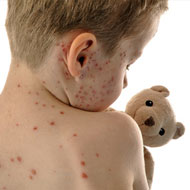 Skin infections caused by the virus from the Human Papilloma Virus (HPV) family are called warts. They are mostly painless until touched and are common in kids. The warts will be painful if they are on the soles or body parts which get bumped or touched frequently. Warts are usually found on the parts of the body which tend to remain moist like small cuts and scratches on the fingers, hands and feet. Luckily there are a lot of warts treatments that can make you kids wart-free.
Skin infections caused by the virus from the Human Papilloma Virus (HPV) family are called warts. They are mostly painless until touched and are common in kids. The warts will be painful if they are on the soles or body parts which get bumped or touched frequently. Warts are usually found on the parts of the body which tend to remain moist like small cuts and scratches on the fingers, hands and feet. Luckily there are a lot of warts treatments that can make you kids wart-free.
What Parents Should Know About Warts
Since warts affect mostly kids, it is very important that parents are aware of the causes, prevention and treatment of warts. Some of the important points are:
- Common skin warts affect around 10 % to 20 % of children.
- Girls are more susceptible to getting warts than boys.
- Children between the age group of 12 – 16 are more prone to getting warts.
- Although warts are contagious, they are usually harmless.
- Warts are more common in childhood; however, they are not seen in infancy.
Warts Treatments
It is not always necessary to take warts treatments, since they generally do not cause any problems. Doctors may suggest removing the warts if they cause pain or interfere in daily activities. If not treated, the warts may disappear on their own in 6 months to 2 years’ time.
1. Use Medications
The medications used for warts contain Salicylic acid which softens and dissolves the warts. These come in the form of liquids, gels, pads or ointments and are available as OTC or prescription medicines. Examples are Compound W, Duofilm and Occlusal HP.
How to use: Before using the medicine, the warts affected area should be soaked in water for about five minutes and then gently rubbed with pumice stone or wash cloth so that the medicine penetrates easily. This pumice stone or wash cloth should not be re-used to avoid re-infection. The medicine should be used daily and may require application for several weeks. Advice should be taken from the doctor even when using OTC medicines as they are quite strong and can damage healthy skin as well.
2. Freeze with Liquid Nitrogen
Using Nitrogen to treat warts is called Cryotherapy or Cryosurgery. The treatment should be repeated 2 – 4 times every 1 to 3 weeks. In this procedure, doctors use liquid nitrogen to freeze the wart and it can cause mild discomfort. If this does not show any effect, another treatment might be required.
3. Duct Tape
This is a home warts treatment where a duct tape or electrical (non-porous) tape is applied on the wart and left on. It is removed only for a few hours per week. The tape should also be changed frequently. The effectiveness of this treatment is not very high and you should consult your doctor before trying this on your child.
4. Other Treatments
When other treatments do not work, doctors may burn, cut or remove the wart with laser. These are effective but can leave scars.
Things to Remember When Applying Warts Treatments
When dealing with warts, there are some things which parents should keep in mind.
- Soak the wart in water to soften the skin and file the wart with emery board to remove dead skin after which the medicine should be applied. This emery board should never be used to file nails and surrounding skin should not be filed.
- When medicine is applied, please remember to cover the warts. And do not allow your child to scratch, rub or pick the wart as this will spread the virus to other areas.
Warts Prevention
The best way to prevent or reduce the risk of getting or spreading warts is to avoid cross-contamination. To achieve that, try some of the following simple tips:
|
Methods |
What to Do |
|
Avoid biting |
It’s easier for the virus to infect broken skin. Hence, avoid biting finger nails and the skin around it would help in reducing the risk of getting warts. |
|
Avoid picking |
Picking warts will spread the infection. Hence, it is recommended to keep the warts covered with bandage to prevent picking. |
|
Keep hands and feet dry |
Warts develop in moist areas, keeping hands and feet dry will make it easier to control warts. |
|
Groom carefully |
Avoid brushing, clipping, combing or shaving areas infected with warts as it can spread the virus. Wash hands if you touch the warts. |
|
Separate the tools |
The pumice stone and emery boards which are used to clean warts should not be used on other body parts as they can carry virus and infect other parts. |
